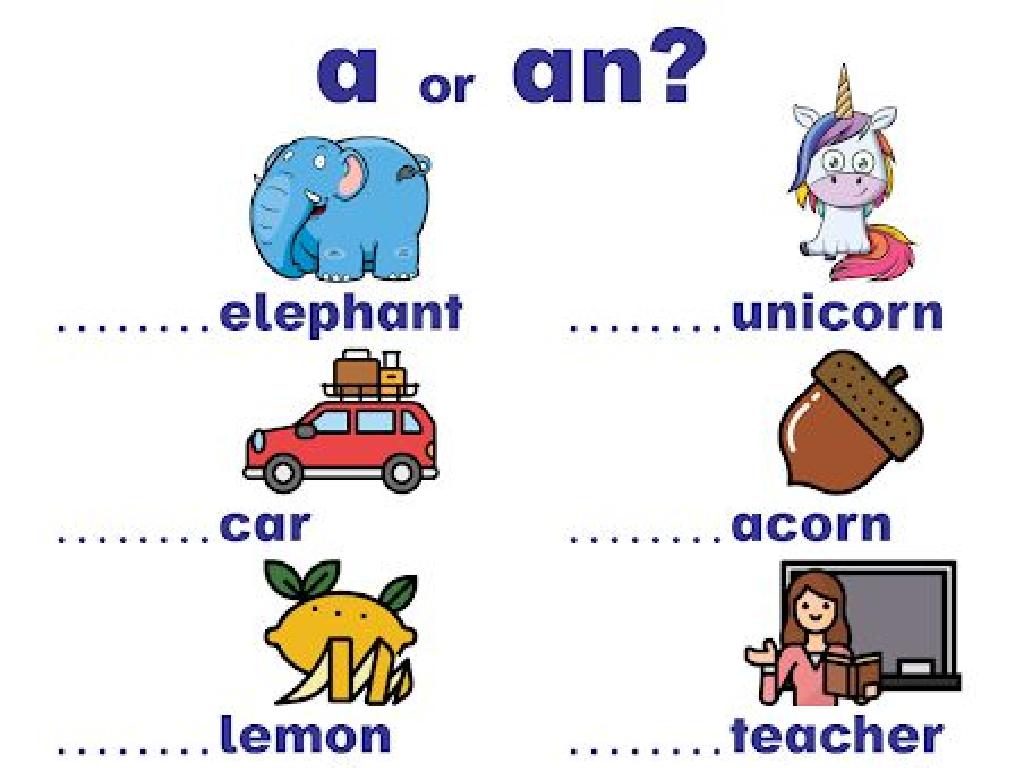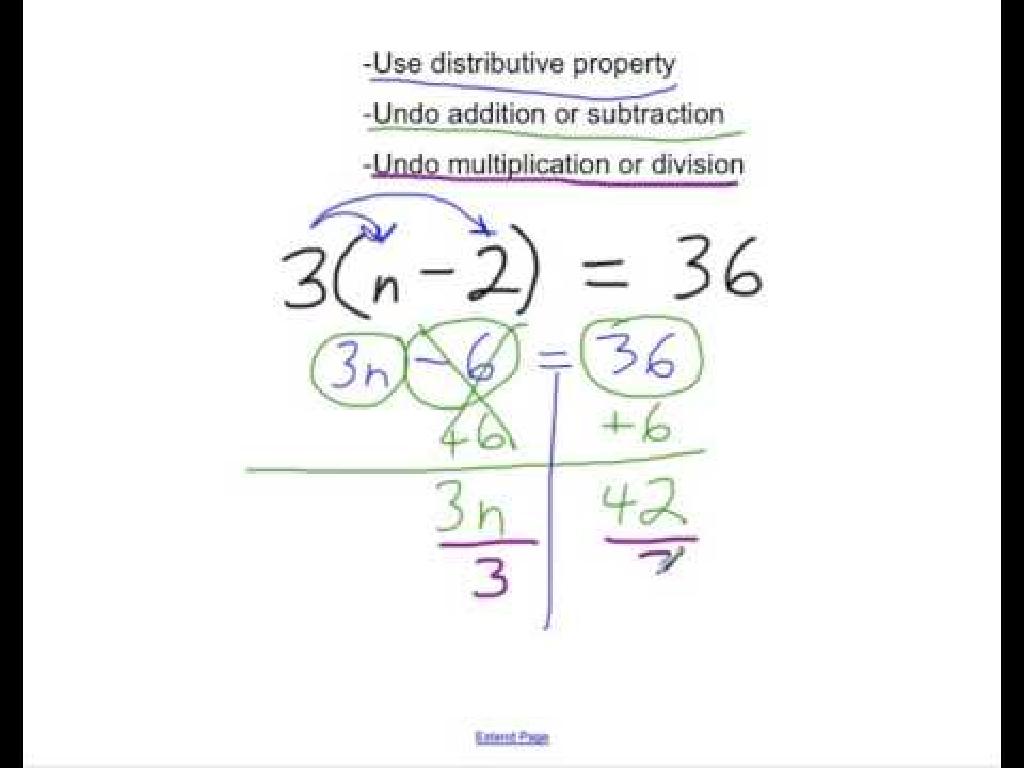Analyze Models Of The Earth-Sun-Moon System
Subject: Science
Grade: Sixth grade
Topic: Astronomy
Please LOG IN to download the presentation. Access is available to registered users only.
View More Content
Exploring the Earth-Sun-Moon System
– Our Solar System introduction
– Earth-Sun-Moon system dynamics
– Earth orbits the Sun, Moon orbits Earth. They affect seasons, tides, and eclipses.
– Models as learning tools
– Models help visualize complex concepts like orbits and phases.
– Significance of celestial models
– Understanding models aids in grasping real-world astronomical phenomena.
|
This slide introduces students to the basics of our Solar System, with a focus on the Earth-Sun-Moon system. Emphasize the roles and relationships between these celestial bodies, such as how the Earth’s tilt and orbit around the Sun lead to seasons, and the Moon’s orbit affects the tides. Highlight the importance of using models to understand these complex systems, as they allow students to visualize and better grasp concepts that are difficult to observe directly. Encourage students to think about how models, even simple ones, can provide insights into the workings of space and foster a deeper appreciation for astronomy.
The Earth-Sun-Moon System: Celestial Mechanics
– Overview of Earth, Sun, Moon
– Earth: our home planet, Sun: the star we orbit, Moon: Earth’s satellite
– Movement and interactions
– They move in space with Earth rotating and orbiting the Sun, Moon orbits Earth
– Understanding orbits
– Orbits are the paths taken by objects in space, like Earth’s path around the Sun
– Exploring rotations
– Rotation refers to an object spinning on its axis, like Earth’s 24-hour spin
|
This slide introduces the basic components of the Earth-Sun-Moon system and their movements. Begin by discussing the roles of the Earth, Sun, and Moon. Explain how the Earth rotates on its axis, resulting in day and night, and orbits the Sun, leading to the seasons. The Moon orbits the Earth and goes through phases. Emphasize the concept of orbits as the gravitational paths that celestial bodies follow and rotations as the spinning of these bodies on their axes. Use diagrams to illustrate these movements and their effects on what we observe from Earth, such as the cycle of day and night, and the changing seasons. Encourage students to ask questions and think about how these movements affect their daily lives.
Understanding Scale Models in Astronomy
– Define a scale model
– A representation or replica of an object with proportions scaled down or up.
– Importance of scale models
– They help visualize and study celestial bodies and distances that are too large or too small.
– Examples in astronomy
– Solar system models, moon phases, or classroom planetarium.
– Creating your own model
– Use common materials to build a model of the Earth-Sun-Moon system.
|
This slide introduces the concept of scale models and their significance in the field of astronomy, where direct study of celestial objects is not feasible due to vast distances. Scale models allow students to grasp the relative sizes and distances in space, making abstract concepts more concrete. Provide examples like a classroom planetarium or models of the solar system where planets are represented with different sized spheres. Encourage students to think creatively and discuss how they might create their own scale models using items like balls, light sources, and measuring tools to represent the Earth, Sun, and Moon.
Phases of the Moon: Understanding Lunar Changes
– Causes of Moon phases
– Moon phases occur due to its orbit around Earth, reflecting sunlight differently.
– Various Moon phase names
– New Moon, Waxing Crescent, First Quarter, Waxing Gibbous, Full Moon, Waning Gibbous, Last Quarter, Waning Crescent.
– Recognizing Moon phases
– Observe the illuminated portion; a crescent indicates a new or waning phase, while a gibbous shows a waxing or full phase.
– Cycle duration and sequence
– The Moon takes about 29.5 days to complete its cycle, starting from New Moon to New Moon.
|
This slide aims to explain the lunar phases, which are caused by the Moon’s position relative to Earth and the Sun, resulting in varying amounts of the Moon being illuminated as seen from Earth. Familiarize students with the names of each phase and their characteristics. Teach them how to recognize these phases in the night sky by observing the shape and amount of the illuminated part of the Moon. Discuss the sequence and duration of the lunar cycle, emphasizing that it takes approximately one month to complete. Use diagrams to illustrate the Moon’s position during each phase, and consider bringing a lunar phase calendar to help students track and predict the phases.
Understanding Eclipses
– What is an eclipse?
– An eclipse occurs when one celestial body moves into the shadow of another.
– Solar vs. Lunar eclipses
– Solar: Moon blocks Sun; Lunar: Earth blocks Sun’s light to Moon.
– Earth-Sun-Moon alignment
– Eclipses happen due to the precise alignment of the Earth, Moon, and Sun.
– Eclipses’ occurrence
– Not random; predictable using astronomy.
|
An eclipse is a fascinating astronomical event where one celestial body is obscured by another, casting a shadow. There are two main types of eclipses relevant to our study: solar and lunar. A solar eclipse occurs when the Moon passes between the Earth and the Sun, blocking the Sun’s light. Conversely, a lunar eclipse happens when the Earth comes between the Sun and the Moon, and the Earth’s shadow falls on the Moon. The alignment of the Earth, Sun, and Moon must be precise for an eclipse to occur, and this alignment is predictable, allowing us to anticipate when eclipses will happen. During the presentation, we’ll explore how these celestial events have influenced human culture and our understanding of the cosmos.
Tides and the Earth-Sun-Moon System
– Moon’s role in Earth’s tides
– The Moon’s gravity pulls on Earth’s oceans, causing tides.
– High tide vs. Low tide
– High tide: Water bulges toward the Moon; low tide: Water recedes.
– Spring tides explained
– Spring tides: Sun and Moon align, stronger tides occur.
– Neap tides overview
– Neap tides: Sun and Moon at right angles, weaker tides.
|
This slide aims to explain the concept of tides and their relationship with the Moon’s gravitational pull. Students should understand that the Moon’s gravity affects the Earth’s water, creating high and low tides. High tides occur when the water is pulled towards the Moon, and low tides when it recedes. Spring tides, which are especially strong, happen when the Sun, Earth, and Moon are in a straight line. Neap tides, which are weaker, occur when the Sun and Moon are at right angles to each other. Encourage students to think about how these tides affect marine life and human activities like fishing and boating.
Understanding Orbits in the Earth-Sun-Moon System
– Earth’s and Moon’s orbit shapes
– Earth’s orbit is elliptical, Moon’s is nearly circular
– Gravity’s role in orbits
– Gravity is the force that pulls the Earth and Moon toward the Sun, keeping them in orbit
– Inertia in celestial movement
– Inertia is the tendency of an object to resist changes to its state of motion
– Balancing gravity and inertia
– Orbits result from the balance between gravity’s pull and the inertia of the Earth and Moon
|
This slide aims to explain the basic concepts of orbits within the Earth-Sun-Moon system. Students should understand that both Earth and Moon have specific shapes of orbits – Earth’s being more elliptical and the Moon’s being closer to circular. Gravity is the force that maintains these orbits, pulling the celestial bodies towards each other and the Sun. Inertia, on the other hand, is the property that keeps the Earth and Moon moving in a straight line. However, due to gravity, they are constantly falling towards the Sun, resulting in an orbit. The interplay between gravity and inertia is what keeps the Earth and Moon in a stable orbit around the Sun. Encourage students to think of examples of inertia they experience in everyday life, like riding a bicycle, to help them understand this balance of forces.
Class Activity: Building the Earth-Sun-Moon Model
– Craft your Earth-Sun-Moon model
– Gather balls, sticks, and clay
– Use different sizes to represent the Earth, Sun, and Moon accurately
– Show orbits and rotations
– Use sticks to demonstrate orbits, and clay to hold your model together
– Explain model’s significance
– Discuss how the model helps us understand celestial movements
|
This hands-on activity is designed to help students visualize and understand the complex movements within the Earth-Sun-Moon system. Provide different sized balls to represent the Sun (largest), Earth (medium), and Moon (smallest). Sticks will be used to connect the balls and demonstrate the orbits, while clay can be used as a base to stabilize the model. Encourage students to rotate their Earth around the Sun and the Moon around the Earth to show the respective orbits. Discuss the importance of the model in understanding phenomena such as seasons, phases of the Moon, and eclipses. Possible variations of the activity could include using a light source to simulate sunlight, showing how the Moon’s phases change, or demonstrating why we have solar and lunar eclipses.
Conclusion: Earth-Sun-Moon System
– Recap of Earth-Sun-Moon interactions
– How do Earth, Sun, and Moon work together?
– Significance of astronomical models
– Models simplify complex concepts like orbits and phases.
– Encourage space-related questions
– Foster curiosity in astronomy
– Always ask ‘why’ and ‘how’ about the universe.
|
This slide aims to summarize the key points about the Earth-Sun-Moon system and the importance of using models to understand astronomical concepts. Emphasize how models help us visualize and comprehend the interactions and movements within our solar system. Encourage students to ask questions about space and to remain curious about the universe. This curiosity drives scientific discovery and understanding. As a closing activity, consider allowing students to ask any lingering questions they have or to share one new thing they’ve learned about space that fascinates them.
Homework: Observing Earth’s Cosmic Neighbors
– Observe and record Moon phases for a week
– Note the shape of the Moon each night. Is it growing or shrinking?
– Diagram Earth, Sun, and Moon during an eclipse
– Show the positions during solar or lunar eclipse. Which is which?
– Write about tides and their impact on Earth
– How do high and low tides influence coastal environments?
– Share observations and findings in class
|
This homework assignment is designed to engage students with hands-on activities that reinforce their understanding of the Earth-Sun-Moon system. By observing the Moon over a week, students will learn about its phases and the regular pattern they follow. Drawing a diagram of an eclipse will help them visualize the celestial mechanics behind these events. Writing a paragraph on tides will encourage them to think about the practical effects of astronomy on Earth’s life. Encourage students to be detailed in their observations and creative in their diagrams. Provide examples of tide effects, such as changes in beach appearance or the best times for fishing. In the next class, create a discussion around their experiences and insights to solidify their understanding.






